Analytics, Energy, Energy Market, Latvia, Statistics
International Internet Magazine. Baltic States news & analytics
Friday, 26.04.2024, 21:32
Increase in the energy produced in CHP plants in Latvia
 Print version
Print version|
Installed electrical capacity of CHP plants |
Number of CHP plants |
Total installed electrical capacity, MW |
Electricity produced, GWh |
Heat produced, GWh |
||
|
TOTAL |
198 |
1 292.1 |
3 767.4 |
6 023.1 |
|
|
|
0.2 MW or less |
22 |
3.0 |
16.4 |
39.6 |
|
|
|
0.2–0.5 MW |
33 |
10.7 |
60.3 |
104.7 |
||
|
0.5–1 MW |
75 |
58.5 |
367.5 |
627.3 |
||
|
1–5 MW |
60 |
135.9 |
851.1 |
1 956.6 |
|
|
|
5–20 MW |
4 |
34.2 |
103.1 |
147.3 |
|
|
|
20 MW or more |
4 |
1 049.8 |
2 369.0 |
3 147.6 |
|
|
In 2016, in Latvia there were 198 active CHP plants with the total installed electric capacity of 1 292.1 megawatts (MW). Since 2007, the installed electric capacity of CHP plants has doubled, and, compared to 2015, the indicator has risen by 1% or 17.0 MW.
In Latvia, there are four CHP plants with installed electrical capacity exceeding 20 MW, comprising 81 % of the total installed electrical capacity of the CHP plants. The volume of electricity produced in these CHP plants accounted for 63% of the total volume of electricity produced in the country. Three of the plants were located in Riga and one in Zemgale region.
In 2016, CHP plants in Riga had the highest installed electrical capacity – 1 059.9 MW, which almost has not changed since 2013. The CHP plant in Zemgale region had the second highest installed electrical capacity (63.8 MW). In 2016, the lowest installed electrical capacity (29.3 MW) was recorded in CHP plants located in Kurzeme region, showing a drop of 5 % over the year. In its turn, the installed electrical capacity of CHP plants situated in Vidzeme region has risen by 36%, reaching 37.5 MW in 2016. Compared to 2015, in 2016 the installed electrical capacity of CHP plants located in Pierīga and Latgale regions has went up by 3% and 9%, respectively.
Electricity produced in Latvian CHP plants in 2016

Natural gas is the main energy source used to produce electricity and heat in Latvian CHP plants. In 2016, the electrical capacity of CHP plants using natural gas constituted 1 147.2 MW. By using 878.8 million m3 of natural gas, these plants produced 4 135.3 GWh of heat and 2 943.0 GWh of electricity.
Installed electrical capacity of CHP plants by type of fuel consumed, 2010–2016 (%)
| 2010 | 2011 | 2012 | 2013 | 2014 | 2015 | 2016 |
Natural gas | 98.1 | 96.9 | 93.8 | 91.2 | 90.1 | 90.0 | 88.8 |
Fuelwood | 0.5 | 0.4 | 1.7 | 4.3 | 5.0 | 5.1 | 6.3 |
Biogas | 1.1 | 2.4 | 4.2 | 4.2 | 4.6 | 4.7 | 4.8 |
Other | 0.3 | 0.3 | 0.3 | 0.4 | 0.3 | 0.2 | 0.1 |
Since 2010, the installed electrical capacity of CHP plants powered by renewable energy sources (RES) has went up nine times, reaching 143.4 MW in 2016. The volume of electricity produced in RES-fuelled CHP plants has grown 12 times, reaching 824.4 GWh, which constitutes 22 % of the total volume of electricity produced in the CHP plants.
The largest share of RES-fuelled CPH plants was registered in Vidzeme and Zemgale region. In 2016, the installed electrical capacity of RES-fuelled CHP plants in Vidzeme (30.4 MW) comprised or 81 % of the total installed electrical capacity in this region, and in Zemgale region the indicator amounted to 79 %. The smallest share of RES-fuelled CPH plants was observed in Riga – only 1 % of the total installed electrical capacity.
Installed electrical capacity of CHP plants, MW | Electricity produced in CHP plants, GWh |
|
|
The increase in the volume of electricity produced in RES-fuelled CHP plants is related to the state aid programmes aimed at ensuring share of RES in the gross energy consumption of 40 % (Regulations of the Cabinet No 129 on energy sector development guidelines for 2016–2020) and reducing Latvian energy dependence upon energy resource imports.










 «The Baltic Course» Is Sold and Stays in Business!
«The Baltic Course» Is Sold and Stays in Business!

